Icariin-based bone scaffold for treating steroid-induced necrosis of femoral head by restoring angiogenesis and promoting osteogenesis
IF 7.6
2区 材料科学
Q1 MATERIALS SCIENCE, MULTIDISCIPLINARY
引用次数: 0
Abstract
Steroid-induced femoral head avascular necrosis (SFHN), a devastating orthopedic condition characterized by ischemic bone collapse, urgently requires interventions addressing both impaired angiogenesis and compromised osteogenesis. Here, we developed an icariin (ICA)-functionalized β-tricalcium phosphate (β-TCP) composite scaffold through an innovative low-temperature rapid prototyping (LT-RP) technique. This strategy fundamentally resolves the critical limitation of conventional high-temperature sintering that compromises bioactivity through thermal degradation. Additionally, by adjusting the ratio of α-TCP to β-TCP, we optimized the mechanical properties of the scaffold, enhancing its suitability for bone repair and ensuring that its degradation rate matches the rate of new bone formation. Furthermore, gelatin was introduced into the porous structure of the scaffold, successfully encapsulating ICA, allowing for sustained release during bone repair. This innovative design significantly improved the osteogenic and angiogenic effects of the scaffold. Animal experiments showed that the ICA-loaded reconstruction scaffold effectively promoted new bone formation and angiogenesis, enhancing the integration between the implant and bone tissue. This bioengineered approach establishes a paradigm for reconstructing necrotic subchondral bone while preserving joint biomechanics.

求助全文
约1分钟内获得全文
求助全文
来源期刊

Materials & Design
Engineering-Mechanical Engineering
CiteScore
14.30
自引率
7.10%
发文量
1028
审稿时长
85 days
期刊介绍:
Materials and Design is a multi-disciplinary journal that publishes original research reports, review articles, and express communications. The journal focuses on studying the structure and properties of inorganic and organic materials, advancements in synthesis, processing, characterization, and testing, the design of materials and engineering systems, and their applications in technology. It aims to bring together various aspects of materials science, engineering, physics, and chemistry.
The journal explores themes ranging from materials to design and aims to reveal the connections between natural and artificial materials, as well as experiment and modeling. Manuscripts submitted to Materials and Design should contain elements of discovery and surprise, as they often contribute new insights into the architecture and function of matter.
 求助内容:
求助内容: 应助结果提醒方式:
应助结果提醒方式:


